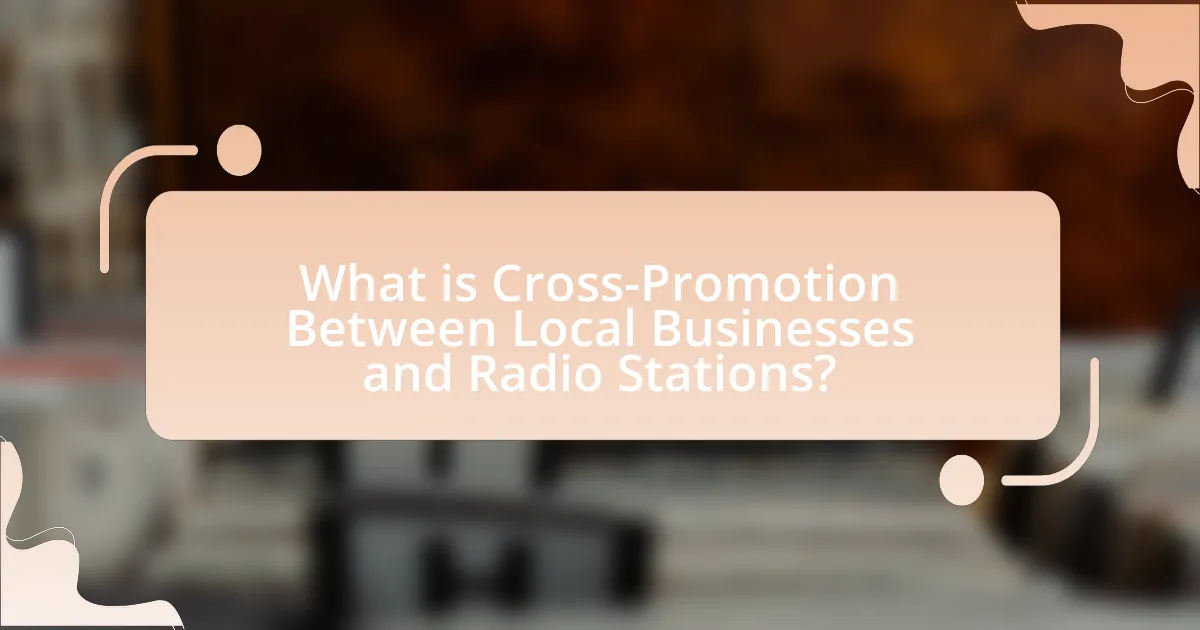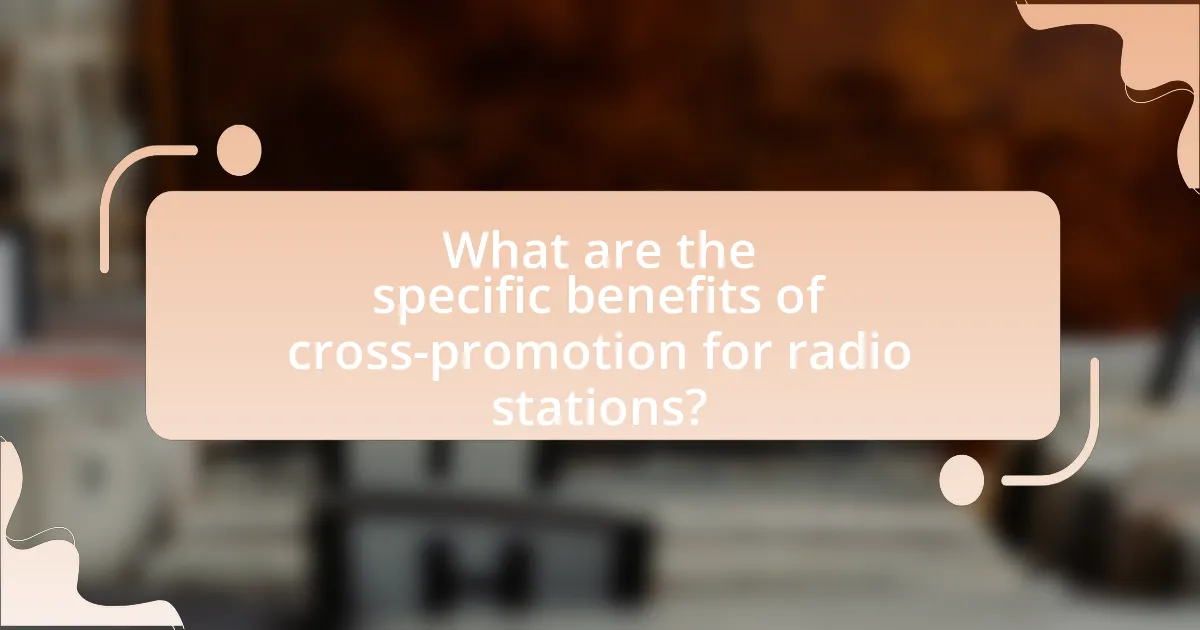Cross-promotion between local businesses and radio stations is a collaborative marketing strategy that enhances visibility and customer reach for both parties. This article explores how local businesses can leverage radio station audiences through sponsorships and promotions, leading to increased engagement and sales. Key elements of successful cross-promotion include strategic alignment, audience targeting, and mutual benefits, while effective collaboration can strengthen community ties and listener loyalty. Additionally, the article addresses the economic advantages for both local businesses and radio stations, potential challenges, and best practices for measuring success and refining strategies.

What is Cross-Promotion Between Local Businesses and Radio Stations?
Cross-promotion between local businesses and radio stations involves collaborative marketing efforts where both entities promote each other to enhance visibility and reach. This strategy allows local businesses to leverage the radio station’s audience while the station gains content and potential advertising revenue. For instance, a local restaurant might sponsor a segment on a radio show, and in return, the station promotes the restaurant through on-air mentions and social media posts. This mutual benefit can lead to increased customer engagement and sales for the business, while the radio station strengthens its community ties and listener loyalty.
How does cross-promotion function in a local context?
Cross-promotion in a local context functions by enabling local businesses and radio stations to collaborate, thereby enhancing their visibility and customer reach. This collaboration often involves businesses sponsoring radio segments or events, which allows them to promote their products or services directly to the station’s audience. For instance, a local coffee shop might sponsor a morning show, leading to on-air mentions and promotions that attract listeners to visit the shop. This strategy not only increases foot traffic for the business but also provides the radio station with content and financial support, creating a mutually beneficial relationship. Studies have shown that local partnerships can increase brand awareness by up to 30%, demonstrating the effectiveness of cross-promotion in driving local engagement and sales.
What are the key elements of successful cross-promotion?
The key elements of successful cross-promotion include strategic alignment, audience targeting, and mutual benefits. Strategic alignment ensures that both parties share similar values and goals, which enhances the effectiveness of the promotion. Audience targeting involves identifying and reaching the overlapping customer bases of both businesses, maximizing engagement and conversion rates. Mutual benefits create a win-win situation, where both entities gain increased visibility and sales, leading to a more sustainable partnership. For instance, a local business collaborating with a radio station can leverage the station’s audience to promote its products, while the station gains content and sponsorship revenue, demonstrating the effectiveness of these elements in practice.
How do local businesses and radio stations collaborate effectively?
Local businesses and radio stations collaborate effectively through cross-promotion strategies that leverage each other’s audiences. This collaboration often includes local businesses sponsoring radio segments, which allows them to reach a wider audience while providing radio stations with financial support. For instance, a local restaurant might sponsor a food-related segment, gaining exposure through on-air mentions and promotions, while the radio station benefits from advertising revenue. Additionally, radio stations can host events or contests that feature local businesses, creating a community-focused atmosphere that attracts listeners and customers alike. This mutual benefit is supported by studies showing that local advertising can increase customer engagement by up to 30%, demonstrating the effectiveness of such collaborations.
Why is cross-promotion important for local businesses?
Cross-promotion is important for local businesses because it enhances visibility and customer reach by leveraging the audiences of partnering businesses. When local businesses collaborate, they can share marketing resources, which leads to increased brand awareness and customer engagement. For instance, a study by the Local Search Association found that 70% of consumers prefer to shop at businesses that support other local businesses, indicating that cross-promotion can significantly influence consumer preferences and drive sales. By working together, local businesses can create a stronger community presence and attract new customers who may not have been aware of their offerings.
What advantages does cross-promotion provide to small businesses?
Cross-promotion provides small businesses with increased visibility and access to new customer bases. By collaborating with other businesses, small enterprises can leverage each other’s audiences, effectively doubling their reach without significant additional marketing costs. For instance, a study by the Local Search Association found that 70% of consumers prefer to shop at businesses that support their local community, indicating that cross-promotion can enhance brand loyalty and community engagement. Additionally, cross-promotion can lead to cost savings in marketing efforts, as businesses can share resources and promotional materials, making it a financially viable strategy for small businesses looking to grow.
How does cross-promotion enhance brand visibility?
Cross-promotion enhances brand visibility by leveraging the audiences of multiple businesses to reach a broader customer base. When local businesses collaborate with radio stations, they can tap into the station’s established listener demographic, increasing exposure to potential customers who may not have been aware of the brand previously. For instance, a study by the Local Media Association found that businesses participating in cross-promotional campaigns experienced a 30% increase in brand recognition and a 20% boost in sales. This collaborative approach not only amplifies marketing efforts but also fosters community engagement, making brands more memorable and accessible to consumers.

What are the specific benefits of cross-promotion for radio stations?
Cross-promotion provides radio stations with increased audience reach and enhanced brand visibility. By collaborating with local businesses, radio stations can tap into the customer base of those businesses, thereby attracting new listeners who may not have previously engaged with the station. For instance, a radio station promoting a local restaurant can encourage the restaurant’s patrons to tune in, resulting in a broader listener demographic. Additionally, cross-promotion often leads to shared marketing costs, allowing radio stations to allocate resources more efficiently while maximizing promotional efforts. This strategy not only strengthens community ties but also fosters a mutually beneficial relationship between the station and local businesses, ultimately driving higher engagement and loyalty among listeners.
How does cross-promotion increase audience engagement for radio stations?
Cross-promotion increases audience engagement for radio stations by leveraging partnerships with local businesses to reach wider audiences. When radio stations collaborate with businesses, they can share promotional content, events, and offers, which attracts listeners who may not have previously engaged with the station. For instance, a study by the National Association of Broadcasters found that stations that actively cross-promote with local businesses see a 30% increase in listener participation during promotional events. This strategy not only enhances visibility for both the station and the business but also fosters a sense of community, encouraging listeners to engage more frequently with the station’s content.
What strategies can radio stations use to leverage local partnerships?
Radio stations can leverage local partnerships by engaging in cross-promotional activities that benefit both the station and local businesses. These strategies include hosting joint events, such as community festivals or charity drives, where the radio station provides promotional support and local businesses gain exposure to a wider audience. Additionally, radio stations can offer advertising packages that include on-air mentions, social media promotion, and website features for local businesses, creating a mutually beneficial relationship. Research shows that local businesses that partner with radio stations can increase their customer base by up to 30%, demonstrating the effectiveness of such collaborations in enhancing visibility and driving sales.
How does cross-promotion contribute to listener loyalty?
Cross-promotion contributes to listener loyalty by creating a sense of community and enhancing the listener’s experience through relevant content. When radio stations collaborate with local businesses, they provide listeners with exclusive offers, events, or promotions that resonate with their interests, fostering a deeper connection. This strategy not only increases engagement but also encourages listeners to return, as they feel valued and part of a local network. Research indicates that 70% of consumers are more likely to support brands that engage in community-focused initiatives, highlighting the effectiveness of cross-promotion in building lasting loyalty.
What economic benefits arise from cross-promotion?
Cross-promotion generates significant economic benefits by enhancing brand visibility and increasing customer reach for both parties involved. Local businesses can leverage the established audience of radio stations to attract new customers, while radio stations gain access to a broader demographic through the businesses’ clientele. This symbiotic relationship often leads to increased sales and revenue for both entities. For instance, a study by the Local Media Association found that businesses engaging in cross-promotion with local media saw an average revenue increase of 20% within the first year. Additionally, cross-promotion can reduce marketing costs, as shared advertising efforts allow both businesses and radio stations to maximize their budgets and achieve greater impact with less expenditure.
How can cross-promotion lead to increased sales for local businesses?
Cross-promotion can lead to increased sales for local businesses by expanding their customer reach and enhancing brand visibility. When two or more local businesses collaborate, they can share their customer bases, allowing each business to access potential customers who may not have been aware of their offerings. For instance, a local coffee shop partnering with a nearby bookstore can promote each other’s products through joint marketing efforts, such as special discounts or events. This strategy not only attracts new customers but also fosters community engagement, which can result in higher sales. Research indicates that businesses that engage in cross-promotion often see a sales increase of 20% to 30%, as they leverage each other’s strengths and customer loyalty.
What financial advantages do radio stations gain from partnerships?
Radio stations gain financial advantages from partnerships primarily through increased advertising revenue and shared marketing costs. By collaborating with local businesses, radio stations can offer bundled advertising packages that attract more advertisers, leading to higher overall income. For instance, a study by the Radio Advertising Bureau indicated that radio stations that engage in cross-promotional partnerships see a 20% increase in ad sales compared to those that do not. Additionally, partnerships allow radio stations to share promotional expenses, reducing their financial burden while enhancing their reach and visibility in the community. This collaborative approach not only boosts revenue but also strengthens community ties, further driving listener engagement and loyalty.

What challenges might arise in cross-promotion efforts?
Challenges in cross-promotion efforts include misalignment of brand values, inconsistent messaging, and audience mismatch. Misalignment occurs when the partnering businesses or radio stations do not share similar values or target demographics, leading to confusion among consumers. Inconsistent messaging can arise when promotional materials do not convey a unified message, which can dilute brand identity and reduce effectiveness. Audience mismatch happens when the audiences of the businesses and the radio station do not overlap significantly, resulting in low engagement and ineffective promotions. These challenges can hinder the overall success of cross-promotion initiatives.
How can local businesses and radio stations overcome potential obstacles?
Local businesses and radio stations can overcome potential obstacles by establishing clear communication and mutually beneficial partnerships. Effective collaboration allows both entities to share resources, such as advertising space and promotional events, which can enhance visibility and customer engagement. For instance, a study by the Local Media Association found that cross-promotional efforts can increase customer traffic by up to 30% for participating businesses. By leveraging each other’s strengths, local businesses can tap into the radio station’s audience, while radio stations can provide content that attracts local consumers, creating a win-win situation that mitigates challenges like limited marketing budgets and audience reach.
What common pitfalls should be avoided in cross-promotion?
Common pitfalls to avoid in cross-promotion include misalignment of brand values, lack of clear communication, and insufficient audience targeting. Misalignment of brand values can lead to a negative perception among consumers, as partnerships should reflect shared principles and goals. Lack of clear communication between the businesses involved can result in confusion about roles, expectations, and messaging, ultimately undermining the effectiveness of the promotion. Insufficient audience targeting may lead to wasted resources, as promotions should be directed towards demographics that are likely to engage with both brands. These pitfalls can diminish the potential benefits of cross-promotion, such as increased visibility and customer engagement.
How can effective communication mitigate challenges?
Effective communication can mitigate challenges by ensuring clarity and understanding among stakeholders. When local businesses and radio stations engage in cross-promotion, clear communication helps align goals, expectations, and strategies, reducing misunderstandings that could lead to conflicts. For instance, a study by the International Journal of Business Communication found that organizations with effective communication practices experience 47% higher employee engagement, which translates to better collaboration and problem-solving capabilities. This enhanced collaboration allows both businesses and radio stations to address challenges proactively, fostering a more productive partnership.
What best practices should be followed for successful cross-promotion?
Successful cross-promotion requires clear communication, mutual benefit, and strategic alignment between the businesses involved. Establishing a shared goal ensures that both parties understand the objectives, which can lead to increased audience engagement and sales. For instance, local businesses can offer exclusive discounts to the radio station’s listeners, while the radio station can promote these offers on-air, creating a win-win scenario. Research indicates that 70% of consumers are more likely to engage with brands that collaborate, highlighting the effectiveness of such partnerships. Additionally, leveraging social media platforms for joint campaigns can amplify reach and visibility, further enhancing the success of cross-promotion efforts.
How can businesses and radio stations measure the success of their campaigns?
Businesses and radio stations can measure the success of their campaigns through metrics such as audience reach, engagement rates, and conversion rates. Audience reach can be assessed by analyzing listener statistics and demographic data, which indicate how many people were exposed to the campaign. Engagement rates can be evaluated through social media interactions, website traffic, and listener feedback, providing insight into how well the audience responded to the campaign. Conversion rates, which track the number of listeners who took a desired action, such as making a purchase or signing up for a newsletter, offer concrete evidence of the campaign’s effectiveness. For instance, a study by Nielsen found that radio advertising can lead to a 29% increase in brand awareness and a 23% increase in purchase intent, demonstrating the tangible impact of successful campaigns.
What role does audience feedback play in refining cross-promotion strategies?
Audience feedback is crucial in refining cross-promotion strategies as it provides direct insights into consumer preferences and behaviors. By analyzing feedback, businesses and radio stations can identify which promotional tactics resonate most with their audience, allowing them to tailor their strategies effectively. For instance, a study by Nielsen found that 70% of consumers are more likely to engage with brands that they feel understand their needs, highlighting the importance of audience input in shaping promotional content. This iterative process of incorporating feedback leads to more effective campaigns, ultimately enhancing engagement and driving sales for both local businesses and radio stations.
What are some practical tips for initiating cross-promotion?
To initiate cross-promotion effectively, local businesses and radio stations should first identify complementary partners that share a similar target audience. This alignment ensures that both parties benefit from increased exposure. Next, they should develop a clear proposal outlining mutual benefits, such as shared advertising space or joint events, which can enhance visibility for both entities. Additionally, establishing a timeline and measurable goals for the cross-promotion can help track success and make necessary adjustments. Research indicates that businesses engaging in cross-promotion can see a 20-30% increase in customer engagement, demonstrating the effectiveness of this strategy.